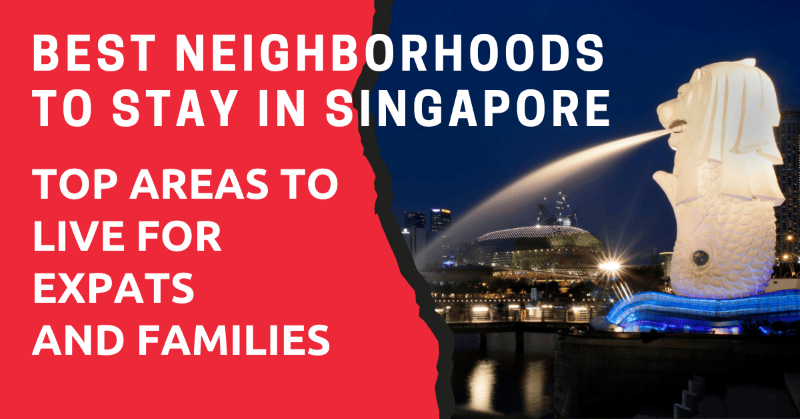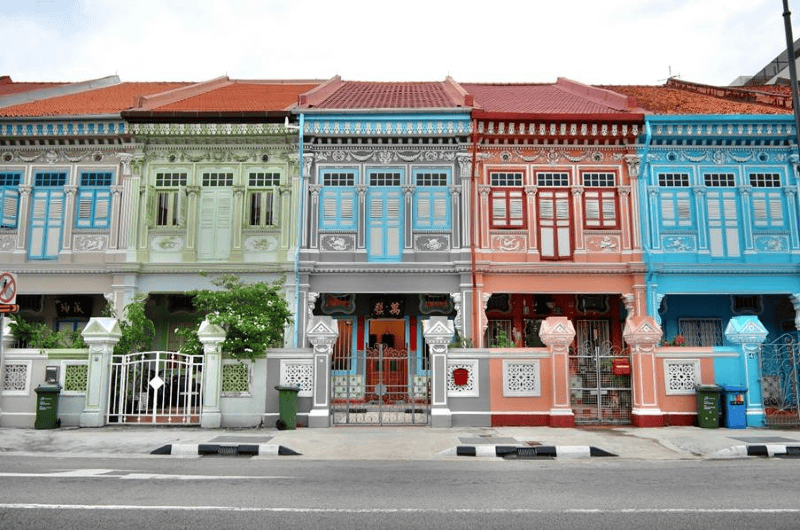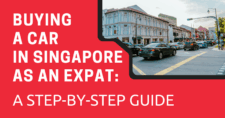
Discover the best areas to live in Singapore, from beachside neighborhoods like Katong to city spots like River Valley. Find out which neighborhood suits your lifestyle and budget.
Living in this tiny little red dot country for more than 15 years, I’ve experienced life in various neighbourhoods from the East to the West side of Singapore. While it’s a small country, there are many neighborhoods you can choose from, and each has different pros and cons.
Of course, everyone has their own preference and opinion. For me, in general, I believe that both East and West have their own perks to offer, and neither is significantly superior to the other. This takes into consideration the ease of transportation, the number of eateries available in the area, and other amenities (groceries, clinics, parks, etc.).
For those who are not really familiar with Singapore, nearly all neighbourhoods are quite self-sufficient with essential amenities available within a radius of 10-15 minutes. With that in mind, choosing a neighbourhood comes down to your personal priorities, or we can call it your three most important determining factors.
This article will take approximately 23 minutes to read. Don't have the time right now? No worries. Email the ad-free version of the article to yourself and read it later!
Disclaimer: This article may include links to products or services offered by ExpatDen's partners, which give us commissions when you click on them. Although this may influence how they appear in the text, we only recommend solutions that we would use in your situation. Read more in our Advertising Disclosure.
Contents
Determining Factors
From what I’ve learned from my own experiences and several experiences from my group of expatriate friends, things to consider when choosing your neighbourhood mostly come down to these points:
- Is proximity to your workplace important? If you have the flexibility to work in a hybrid setting like many on the island, you have more options. The distance from most places in Singapore is about a 45-minute to 1-hour drive.
- Do you need to be in the area where your preferred kids’ school is located?
- Do you have your own car, or will you rely on public transport? Don’t forget about how amazingly reliable the transportation system is here.
- Do you prefer restaurants and bars nearby or nature nearby?
- Are you going to utilize your stay in Singapore to travel around the region? And/or will your work include a high amount of traveling time?
Singapore Neighborhood Overview
Before I dive into each neighborhood, I want to give you a quick idea about Singapore. The island can be divided into three main parts: East, West, and Central. Each area has its own characteristics, pros, and cons.
- The East Side: The East side has beach access, with places like Katong and Joo Chiat known for their vibrant food scene and proximity to East Coast Park and Changi Airport.
- The West Side: The West side is all about greenery and space. Areas like Bukit Timah and Holland Village are surrounded by nature parks and top international schools. It’s quieter here, with a strong family and expat community vibe.
- The Central Area: The Central area is right in the middle of it all. River Valley, Tiong Bahru, and Orchard are packed with restaurants, shopping malls, and nightlife. It’s where you live if you want to be close to work and entertainment, though it’s busier and more expensive.
No matter where you choose, public transport makes it easy to get around the island in under an hour.
East vs West Rivalry
Ask any local Singaporean where they think the best area to live is, and you will hear two very different answers depending on which side of the island they grew up on. The playful East vs West rivalry in Singapore has been around for decades. It started years ago when Singapore’s Urban Planning Strategy deliberately developed major towns on both sides of the island (i.e., Bedok and Tampines in the East, and Clementi and Jurong in the West).
Families naturally put down roots near their workplaces, schools, and extended relatives. Over time, loyalty formed. So, while the East vs West debate may never truly settle, it’s less about objective “better living” and more about where your roots and memories lie.
East Side
The East side of Singapore is known for its coastal area and proximity to Changi Airport.
The three neighbourhoods in the East side that consistently rank as top choices for expatriates are: Katong/Joo Chiat, Bedok/Siglap, and Pasir Ris/Tampines. Before diving into each, let’s take a look at the overall vibe and key features of living in the East.
The Pros:
- The standout highlight of East-side living is undoubtedly East Coast Park (ECP), offering beach access, seaside walks, cycling lanes, and plenty of water and beach sport activities.
- Proximity to Changi Airport is another unbeatable advantage. You can reach the airport in less than 30 minutes.
- With the newly operational Thompson East Coast Line (TEL), often called the “brown line,” the East has become more accessible than ever, complementing the existing East-West Line (EWL) or “green line,” which already connects much of the area.
- Another perk is the relatively short commute to the CBD area, reducing travel time for many professionals.
- Lifestyle-wise, the East is known for its laid-back vibe, vibrant food scene, and abundance of outdoor cafes and alfresco dining spots.
The Cons:
- Nature parks are more limited compared to other parts of Singapore.
- Some areas remain less connected by MRT, meaning buses or private transport are still necessary.
- Prices have also been climbing as more expats move into this side of the island.
- Finally, certain pockets can feel a little removed from the buzz of the city center and lack the central-style amenities of high-end boutiques or trendy nightlife spots.
Overall, the East is perfect for expats who value a coastal lifestyle, easy access to the airport, and a more relaxed, family-friendly environment without straying too far from the city.
Katong/Joo Chiat
Best for: Foodies, heritage lovers, and beach enthusiasts who want a vibrant yet relaxed neighbourhood with easy access to both the city and the airport.
This is my top favourite area in the East. Let’s start with the sheer number of eateries here. From cafes and restaurants to small stalls near Geylang Serai, which is one of the biggest wet markets in Singapore, you’ll find everything from authentic local dishes to modern fusion cuisine, always bustling with people.
You can go for brunch with your friends at a different spot every weekend, as new cafes keep popping up, adding to the already vibrant row of fantastic dining options along Joo Chiat Road and East Coast Road. Extra tips for those with specific dietary needs (e.g., halal food): the stretch near the beginning of Joo Chiat Road and around Geylang Road/Changi Road is a true haven for halal food.
Katong/Joo Chiat is also rich in shophouses or Peranakan houses, full of charm and character. Peranakan refers to the blending of Eastern and Western cultures, or some also call it Eurasian heritage.
Here, you can choose to stay in one of these lovely heritage Peranakan houses, standalone terrace houses, or landed properties. Of course, if you prefer something modern, there are plenty of stylish condos in the area, with the bonus of a beach view if you’re lucky.

The laid-back lifestyle in this area is amplified by being just a stone’s throw away from East Coast Park.
If you love the beach, water sports, or simply strolling, cycling, or rollerblading by the beachside, this is the place for you, no questions asked. Stretching about 15km long, ECP is a weekend hotspot for expats. Whether you’re walking the dog, having a BBQ with friends, flexing your beach volleyball skills, doing yoga, or even trying out wakeboarding, ECP offers all of it.
Katong/Joo Chiat is also known for its strong expat community, making it easy to meet new friends for alfresco drinks on a Friday evening. And if your social plans take you to the CBD instead, the area is just a short MRT ride away, convenient for getting home even after one too many drinks.
Finally, let’s not forget the proximity to Changi Airport, which is the cherry on top for many expats. Most expats will maximize their stay in Singapore by traveling around the region. Living in the East means you can reach the airport in under 30 minutes by taxi. Combine that with Changi’s famously efficient immigration and security clearance, and you will find that every getaway, whether a quick weekend trip or a longer holiday, starts and ends on a stress-free note.
Bedok/Siglap
Best for: Families and expats seeking a quieter, more suburban lifestyle with excellent amenities and affordable housing, all while staying well-connected to both the city and Changi Airport.
How I would describe Bedok/Siglap is that it’s a more suburban, established town with good malls, parks, a lake, and several reputable schools. Some people like this area because, for one reason or another, it gives them a bit of a village feel.
While Bedok may not match Katong/Joo Chiat in terms of proximity to East Coast Park, it has its own gem, the famous Bedok Reservoir, just a stone’s throw away. It’s a very popular place for morning walks, jogging, or simply hitting those daily step targets.
Another plus: while residents of Katong/Joo Chiat may still need about 30 minutes to reach Changi Airport, living in Bedok means the journey to the airport is even shorter. And that translates to cheaper taxi or Grab fares (though the MRT is also an option, with the airport just three stops away).
As one of Singapore’s more mature neighbourhoods, Bedok is also well-known for its rich culinary scene, from local hawker food to western restaurants, cafes, and bars. For expats, this is a great place to dive into traditional Singapore dishes such as nasi lemak, chwee kueh, char kway teow, fish ball noodles, and chicken rice.

When it comes to housing options, it mostly leans towards family-friendly style condos, townhouses, and some landed homes in certain parts of the area. It’s generally on the quieter side, with less hustle and bustle compared to Katong/Joo Chiat, making it ideal for families.
While Bedok doesn’t have as strong an expatriate community, the flip side is that housing prices here are relatively more affordable than in Katong/Joo Chiat, giving you more value for your money while enjoying many of the same East-side benefits.
West Side
When people talk about the West of Singapore, most expats are usually referring to Holland Village/Clementi, West Coast/Jurong, and Bukit Timah/Upper Bukit Timah.
While the area has no beach access, it has many green parks and good international schools. Having lived in this area for more than six years, I can share the key characteristics of West-side living.
The Pros:
- The biggest advantage of living in the West is the abundance of green pockets. As a nature lover, I really enjoy morning and afternoon walks at places like MacRitchie Reservoir, Bukit Timah Nature Reserve, the Green Corridor, and West Coast Park.
- The West is also home to many long-standing and well-regarded international schools, making it a popular choice for expat families with children, as well as those working in the education sector at institutions like Nanyang Technological University (NTU) or the National University of Singapore (NUS).
- Another plus is the proximity to the Second Link crossing the border into Johor Bahru (JB), which is especially popular on weekends. This makes short trips for shopping at Johor Premium Outlet (JPO) or family fun at places like Legoland possible in under 30 minutes.
- On top of that, the West houses many of Singapore’s biomedical, tech, science, and industrial hubs, so living here often means a shorter commute to work and more time to sleep in.
The Cons:
- On the flip side, the West has no proper beach access, which makes it less scenic compared to the East, with fewer opportunities to enjoy the sea breeze.
- Trendy nightlife options are also limited.
- Housing in parts of the West, especially Bukit Timah, can be very expensive as it’s a well-established and prestigious area highly sought after by expat families.
- Although the Downtown Line (DTL) or “blue line” has improved connectivity, some parts of Bukit Timah are still only accessible by bus or private car, which can be slightly inconvenient for some people.
Overall, the West is perfect for families who are nature lovers, and professionals who value green spaces, major universities, and proximity to good schools and tech/science hubs, even if it means trading the beach and nightlife for more peaceful surroundings.

Holland Village / Clementi
Best for: Expats who want a family-friendly neighbourhood with a strong international community, excellent amenities, and a central yet relaxed lifestyle close to both work hubs and green spaces.
The West-side neighbourhood I would choose again and again is the Holland Village/Clementi area, often referred to as an old expat favourite. Here, you’ll find a wide range of modern condos with full facilities such as swimming pools, BBQ areas, playgrounds, and tennis courts, which are perfect for families.
The area also offers low-rise apartments, townhouses, and landed homes for those who prefer more space and a quieter living style.
One of the things I love most about this area is the abundance of eateries, restaurants, and cafes ranging from local hawker food to international cuisine. It’s the kind of place where you dine out even if you don’t feel like dressing up. Just a short distance away is Dempsey Hill, another lifestyle destination known for its artsy vibe and upscale dining, where you will be spoiled for choice with restaurants.
Holland V (as it’s commonly called) has a strong expat community, giving the area a unique vibe with a high mix of expats and locals. It is also a well-connected district, with proximity to both the city centre and Singapore’s major tech and biomedical hubs. Offices in places like Fusionopolis, Biopolis, and Mediopolis are just within 15 minutes of travel time, making it ideal for professionals who prefer a shorter commute and a little extra sleep in the morning.
This is also a wonderfully family-friendly environment, with the Singapore Botanic Garden only two MRT stops away. The Garden is a perfect spot to do various activities from morning walks/jogs, walking your fur baby, catching outdoor live music or small concerts, playing frisbee, or simply enjoying a picnic with the family over the weekend.
Bukit Timah
Best for: Families and expats who prioritize greenery, top international schools, and a tranquil, exclusive lifestyle, even if it means fewer shopping and nightlife options.
This neighbourhood is known as an upscale residential area that is also very family-friendly, with plenty of lush greenery as your backyard. Bukit Timah Nature Reserve and MacRitchie Reservoir are the go-to options for nature lovers and family outdoor activities any day of the week.
Bukit Timah also has a high concentration of international schools, such as the Swiss School, Holland International, Singapore Korean International School, and the German European School Singapore. For those who value club living, the Japanese Association, Hollandse Club, Swiss Club, and British Club are all located nearby.
While it’s often rated as an excellent choice for expats seeking a peaceful and family-oriented environment, the area does come with some trade-offs. Public transportation is relatively limited, with buses being the main mode of travel. The Downtown Line (DTL) or “blue line” is available only at certain spots (e.g., Beauty World, King Albert Park, Sixth Avenue), which can mean longer commute times for professionals heading to offices in the CBD area.
The area still provides a good selection of amenities, though shopping options are more limited compared to other neighbourhoods. You won’t always find your favourite grocery store just a few steps away.
With its tranquil setting, Bukit Timah also has limited nightlife and entertainment options. For more vibrant activities, you will need to head downtown. While it offers a serene lifestyle surrounded by greenery, it is relatively quieter compared to the bustling city centre.
The Central
I’ve been living here for the past five years, and I couldn’t imagine a better place to call home. Convenience is the keyword since you live in the central area of everything. The top areas chosen by most expats in Singapore are River Valley/Tiong Bahru, Orchard/Tanglin, Novena/Newton, and Bugis/Kallang.
The Pros:
- Connectivity is excellent. You can get just about anywhere, making it easy to arrange an appointment or meet-up with less than 30 minutes’ notice.
- The area is also filled with shopping malls, eateries, grocery stores, and every other amenity you might need.
- You will also find top medical facilities, international schools, and embassies located in this area.
- The CBD, where many financial institutions are based, is just a few MRT stops away.
The Cons:
- Housing here is primarily condo living, which can mean more limited space. However, certain areas such as Tanglin offer more options for landed houses and bungalows, though these come with a premium price tag.
- Living in the central area could mean crowded neighbourhoods and noise around your home, making it a challenge for those who love quiet environments.
River Valley/Tiong Bahru
Best for: Expats who value vibrant city living, rich culture, and easy access to nightlife and dining, with a mix of modern convenience and heritage charm.
River Valley offers primarily condo living with a vibrant atmosphere, making it especially popular among single expats and those who enjoy a dynamic social scene. The area blends residential and commercial properties, providing easy access to some of the island’s most famous shopping, dining, and entertainment options.
Living here means you are just steps away from the three iconic quays of Clarke Quay, Boat Quay, and Robertson Quay, ensuring that your social life is always within reach.
With three MRT lines (e.g., Blue Line, Brown Line, and Green Line) running through the area, connectivity is excellent. Do note that rental prices are higher compared to many other neighbourhoods. Green spaces are also limited, with Fort Canning Park being the main recreational option nearby.
Tiong Bahru, on the other hand, is one of Singapore’s most charming and artsy neighbourhoods with a laid-back vibe. Known as a mature residential area, it offers a unique blend of local and expat communities. The area mixes modern high-rise condos with rich heritage architecture, including restored pre-war buildings and art deco structures turned into stylish modern spaces.
The streets are dotted with trendy coffee shops, picturesque cafes, indie boutiques, local bookstores, and bakeries, all set against small parks and leafy corners, giving the neighbourhood its distinct character.
With its popularity among both tourists and locals, you can expect constant weekend crowds, especially in the morning. A highlight is the Tiong Bahru Market, a favourite spot for both expats and locals to shop for fresh produce, flowers, and enjoy delicious local hawker food alongside a coffee fix at nearby cafes.

3. Orchard/Tanglin
Best for: Expats who want luxury living in the heart of the city, with unmatched convenience and a lively atmosphere.
Orchard is the heart of it all – an upscale neighbourhood known for its luxury condos, world-class shopping, dining, and entertainment scene. Orchard has everything you need to keep you busy any time of the day, and it is also located just minutes from the CBD. Several international schools (e.g., EtonHouse, Tanglin Trust School, and Invictus International School) and medical facilities such as Mount Elizabeth Hospital, Camden Medical, and Gleneagles Hospital are located here, making it one of the most convenient areas for expats.
While living here comes at a premium, the area is well-served by multiple bus routes and MRT lines (Red Line and Brown Line), meaning you can comfortably live without owning a car. Do note that the Orchard area can be very crowded and noisy, especially on weekends, with heavy traffic congestion being common. Green spaces are limited compared to other neighbourhoods, so this area is better suited for those who need an urban lifestyle rather than those who want a quiet life.

Tanglin, by contrast, offers a quieter atmosphere with a stunning mix of colonial architecture and lush tropical greenery. Home to some of the island’s most luxurious residences, it is also where many of Singapore’s embassies are located, giving it an exclusive yet stately feel.
(Photo credit: Unsplash)
The Rest of Singapore at a Glance
With ongoing property developments in the area, Northeast Sengkang & Punggol have become popular for new families with young children. It is easy to find playdates for your kids here, as the community is very family-oriented.
Property prices are steadily rising as more amenities continue to appear, complementing the natural attractions that remain a big draw, such as Punggol Waterway and Coney Island, which are adored by nature lovers.

For ultra-luxury living, nothing quite compares to Sentosa. If you are able to splurge a little bit on rent, you can enjoy resort-style living with pristine beaches, luxury hotels and resorts, and golf courses literally in your backyard. While it feels like a resort, there is still a strong neighbourhood vibe and a sense of community within this exclusive island.
Woodlands is another good alternative, especially for those seeking more affordable housing or wanting to raise a family away from the city centre. It is particularly popular with American expatriates due to its proximity to the Singapore American School.
The area also offers a suburban living feel. Despite being located at the northernmost part of Singapore, Woodlands provides plenty of dining options, shopping malls, and leisure activities to keep residents engaged. Its close proximity to the Causeway Link also makes weekend trips to Johor Bahru quick and convenient.
Which Area Should You Live In?
There you have it! Always keep in mind your three key determining factors when choosing a place to live. Here’s a quick summary:
- Katong/Joo Chiat (East): Great if you want a relaxed lifestyle near the beach and love good food. You’ll also be close to Changi Airport for frequent travel.
- Holland Village or Bukit Timah (West): Ideal for families with kids, especially if they’re attending international schools. You’ll get more space and easy access to nature trails.
- River Valley or Tiong Bahru (Central): This is the area if you want to be in the center of everything, living a city living with bars, cafes, and nightlife within walking distance.
- Orchard/Tanglin (Central): Best if you want luxury living and don’t mind paying more to be near world-class shopping and medical facilities.
If you’re unsure, you can start with a short-term rental in River Valley or Tiong Bahru, then explore the East and West before committing long-term.
One of the great things about Singapore is its compact size. You can easily travel from one end of the island to the other in about 45 minutes. This means you can’t really go wrong with your choice, as every neighbourhood is well-equipped with amenities and supported by reliable public transportation.
With all that said, the real question remains: who wins the battle?







